
Most owls are nocturnal predators, with hooked bills and needle sharp talons (claws). They have wide wings, lightweight bodies, and feathers specially designed to allow them to silently swoop down on prey. Depending on the species, adult owls hoot, screech, or whistle.
More than a dozen species of owls live in Washington. The great horned owl (Bubo virginianus)(Fig. 1,4) is the species most often seen and heard. It is the most widely distributed owl in both Washington and North America, occupying dense forests, open woodlands, clear-cuts, deserts, and urban environments, including golf courses, cemeteries, and parks with adjacent woodlots. However, except where noted, information about this species applies to most other owls.
Facts about Washington owls
Food and Feeding Habits
- Great horned owls primarily eat small mammals such as rabbits, skunks, and rodents. They also eat a variety of birds, including quail, ducks, and smaller owl species.
- To a lesser extent, great horned owls eat reptiles, amphibians, fish, and insects.
- Owls have keen hearing and keen vision in low light, both adaptations for hunting at night. Since their eyes don’t move in their sockets, they rotate their heads on their flexible necks.
- Great horned owls use a sit and-wait approach, watching from a perch and swooping down on passing prey to seize it with their talons.
Reproduction
- Great horned owls are early nesters. Pair formation can occur from mid-January to mid-March, depending on the north-south range and elevation.
- The male owl chooses a nest site and attempts to attract a female by frequent hooting.
- The female incubates one to four eggs for 30 to 36 days. The male provides her food and guards the nest.
- The young remain in the nest for about six weeks, and then climb out onto nearby branches. They begin taking short flights at seven weeks, and can fly well at nine to ten weeks.
- Both parents feed and tend the young for several months, often as late as September.
Nests and Nesting Sites
- Great horned owl nests are located high up in trees—generally in the crotch of a branch next to the trunk. Where suitable nest trees don’t exist, owls will use rock ledges, power-line towers, haylofts, and nest boxes.
- Great horned owls make little if any effort to construct nests or even to repair suitable existing ones. Rather, they customarily usurp the previous year’s nest made by a red-tailed hawk, crow, magpie, great blue heron, or tree squirrel.
- An owl seldom uses the same nest more than once, because trampling by the young usually reduces any nest to a disintegrating mass of sticks.
Mortality and Longevity
- Adult great horned owls may be killed or seriously injured when attacking prey. It is, for instance, common to find these owls riddled with porcupine quills or reeking of skunk scent.
- About 50 percent of the young that leave the nest die within their first year from starvation, vehicle collisions, and various other causes.
- The oldest banded great horned owl recovered in the wild was 13 years old. Captive birds can live almost 30 years.
Common owls of Washington
Some owls are uncommon or unlikely to be seen on your property due to their habitat preferences. These include the great gray owl (mountains), burrowing owl (shrub-steppe areas), and the threatened spotted owl (old-growth forests). The following owl species are seen or heard around wooded rural properties, agricultural areas, and large urban parks.
The great horned owl (Bubo virginianus) is easily identified by its large ear tufts or “horns.” It’s also called the cat owl because the tufts look like cat ears.
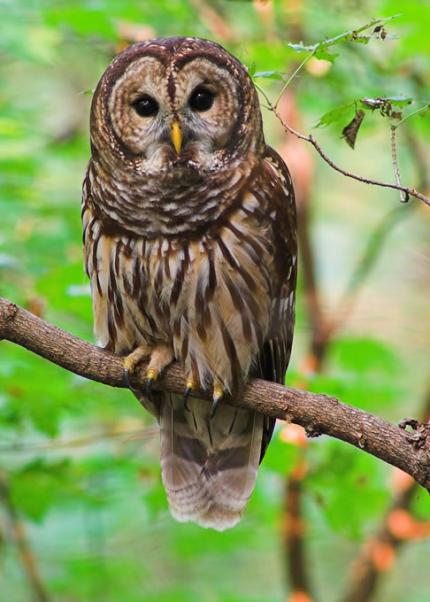
The great horned owl stands 20 inches tall and has a 48-inch wingspan. It is dark brown with black spots above; the underparts are pale brown with heavy, dark brown bars. Some subspecies are paler. All have large yellow eyes. Great horned owls can turn their heads 270 degrees either way when facing forward, but they can’t turn their heads 360 degrees.
The barred owl (Strix varia)(Fig. 2) is similar in size to the great horned owl, but has dark eyes, a thicker appearing neck, and no ear-tufts. The barring pattern on the neck and breast is crosswise and lengthwise on the belly.
Barred owls are native to eastern North America, east of the Great Plains and south of the US-Canada border. Human-driven changes to the northern Great Plains and the lower northern Boreal Forest following European settlement created the conditions to allow barred owls to expand their range westward, with the first barred owls documented in western Washington in 1972, and the first breeding record in 1974.
The barred owl is distinguished from the spotted owl (Strix occidentalis caurina) by its streaked belly (spotted owls have a combination of spots and bars). Barred owl presence in northern spotted owl territories has been identified as the primary threat to the survival of the northern spotted owl. Barred owls are larger, more aggressive, and more adaptable than northern spotted owls. They displace spotted owls, disrupt their nesting, and outcompete spotted owls for food.
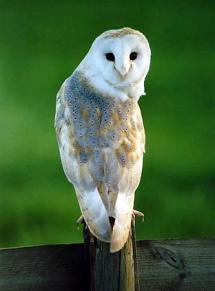
The barn owl (Tyto alba)(Fig. 3), with its white, heart-shaped face, no ear-tufts, dark eyes, and golden-buff plumage with ghostly light underparts, is distinctive and unique. It has a 39-inch wingspan, and its long legs give it a height of up to 20 inches. The barn owl has a preference for rats and other rodents and earned its name by readily nesting in barns, silos, and sheds.
The Western screech owl (Otus kennicottii) is a small owl, with a height of 10 inches and a 20-inch wingspan. Adults are dark brown or gray with small ear-tufts. A year-round resident throughout Washington, it nests in tree cavities, including old woodpecker holes, but will also use nest boxes. Screech owls favor areas near water, and eat rodents, small birds, and large insects, as well as the occasional fish, crayfish, or amphibian.
The Northern saw-whet owl (Aegolius acadicus) is 8 inches tall with an 18-inch wingspan. It has dark brown plumage, brown and white vertical breast streaks, and no ear-tufts. This seemingly tame, fearless little owl moves from higher elevations to valleys in winter. Like the screech owl, it nests in tree cavities and will use a nest box. It prefers dense coniferous and broad-leaved forests next to water. It eats small mammals, including shrews and mice, and will also catch small birds and bats.
The Northern Pygmy-owl (Glaucidium gnoma) is our smallest owl, at 7 inches tall, including its long tail. Because of its size, long tail, proportionally small head, and daytime hunting behavior, the Pygmy-owl is often misidentified or overlooked as just another brown bird in the brush. Watch for it near your winter feeder, where this fearless hunter may attempt to take small birds or mammals. It has sharply streaked undersides, but the most telling marks are the black patches on the back of its head that mimic eyes to deceive predators.
Viewing owls
Visual encounters with owls are relatively rare, because they spend most of the day perched high in trees, inside tree cavities, or in nest boxes. Due to its size, the Northern pygmy-owl almost always goes undetected. The screech owl camouflages itself by stretching tall, holding its wings close to its back, and appearing to be a dead stub on a tree branch.
You are more likely to hear an owl than to see it. If you remain quiet, you can sometimes spot a calling owl with your flashlight. Make every effort not to disturb an owl during its late winter to spring nesting season, a critical time in its yearly cycle.
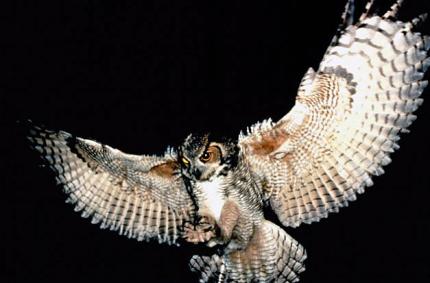
Owls can also be viewed when crows, jays, magpies, or other birds discover them in their territory. The birds will defend their domain by diving and calling repeatedly at the perched or flying owl, an activity called “mobbing.” Look and listen for this behavior and see if you can locate the “invader.”
A good way to learn more about owls that live around you is to go on an owl walk with members of your local Audubon Society. Field trips, sharing ideas and sightings with others, and having access to local bird experts are some excellent ways to gain more knowledge.
A field guide to birds is helpful to identify owl species. Popular field guides and websites are listed below under Additional Information.
Roost Sites
Owls roost in places that offer maximum concealment during daylight hours, choosing trees with dense foliage. Conifers are favored when present; in deciduous forests, owls will use trees that hold clusters of dead leaves over winter.
During the day, scan tall trees for the silhouette of an owl. Also, look for the whitewash of droppings on branches and rocks, and owl pellets on the ground. At dusk or at night, look or listen for an owl roosting in the area.
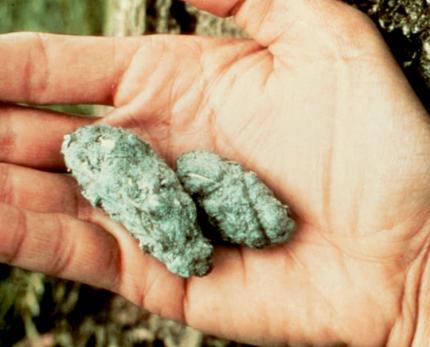
Pellets and Droppings
Typically, owls ingest entire animals—including feathers, fur, teeth, and bones. The undigested material is bundled into compact pellets and later regurgitated (Fig. 5). Pellets are usually found under or near the owl’s favorite roost.
Pellets range from ½ inch to 4 inches long, depending on the owl’s size and its diet. Pellets, shiny and black when new, turn gray with age.
Owl droppings are semi-liquid and primarily white; a whitewash can sometimes be seen under a nest or roost site.
Nest Sites
Look for the stick nests, originally built by large birds or squirrels, which great horned owls use. In deciduous trees these nests are easy to see in the winter, as the trees remain bare into the nesting season.
Calls
Owl calls are given at different times of day and year, depending on the species, and are associated with territorial behavior, courtship, or begging by the young. The following are the common calls given by each owl species:
Great horned owl: a series of four or five deep, resonant hoots given in various rhythms by different individuals: hoo-hoo-hoo; hoo-hoo (“who’s a-wake, me too”). Calls are heard most in the early evening or predawn hours. The male gives them in all seasons, but commonly in fall and winter as he advertises and defends his territory. The call may be answered in an unhurried way by another owl.
Occasionally two or more owls can be heard hooting, seeming to respond to one another.
This is probably territorial hooting between males, since females are silent except for the few weeks of courtship. Juvenile great horned owls beg with a high, scratchy reeeek well into the summer. The call is similar, but usually shorter and less rasping, than the barn owl’s call.
Barred owl: a clear-voiced series: hoo-hoo-hoo, hoo, hoo-hoohoo-hoo-a-aw. Given in words: “who-cooks-for-you, who-cooksfor-you-a-all,” ending with a descending note.
Western screech owl: a slow but accelerating series of short mellow whistles, pwep pwep pwep pwep pwepwepwepepepep, that is slightly lower at the end. Also a two-part trill, with the second part longer. Other calls infrequently heard include a soft bark and a short chuckle.
Northern saw-whet owl: low, whistled toots (about two per second): toit toit toit… or poo poo poo. Also a wheezy, rising, catlike screech: shweeee.
Northern Pygmy-owl: a soft, hollow toot (one note every two seconds). Also a high rattle or rapid trill: tsisisisisisisi.
Barn owl: a long hissing or raspy scream, cssssshhH which sounds similar to a canvas being ripped. The call is similar to, but usually longer and more raspy, than the call for food made by juvenile great horned owls.
Attracting owls
Things you can do to encourage owls to live or visit your property include:
- Retain multi-acre patches of coniferous and/or deciduous trees.
- Protect quiet, secluded areas near rivers, creeks, and lakes and away from human activity.
- Retain large dead or dying trees—over 20 feet tall—as potential perches.
- Protect or plant hedgerows and thickets to attract small mammals that owls eat.
- Leave large grasslands alone or mow them only infrequently to provide habitat for small mammals that owls eat.
- Manage mice and rat problems without poison baits, which can potentially kill owls.
- Install owl nest boxes for barn owls, Western screech owls, Northern Pygmy-owls, and Northern sawwhet owls.
- Install perch poles.
Preventing Conflicts
Because of their wide-ranging diet that includes rabbits, squirrels, chipmunks, and songbirds, great horned owls elicit mixed emotions in people, even wildlife-lovers.
Tips to prevent conflicts or remedy problems
Enclose Domestic Animals
Free-roaming chickens, ducks, turkeys, pigeons, small domestic rabbits, and similar animals are susceptible to owl predation. Although rare, there have been reports of great horned owls preying on unattended puppies and small cats. Birds are particularly vulnerable because they are usually conspicuous and concentrate in areas that lack brush or trees to hide in.
By far the best defense is to house domestic birds in a durable, fenced enclosure that will allow the birds to safely eat and loaf outside during the day. Such a structure can be constructed with a wooden framework that is entirely covered with 1-inch poultry wire or similar netting. This outdoor run can be permanent and attached to a coop or other building, or be a portable and moved periodically.
Where a complete and permanent enclosure isn’t practical or desirable, escape cover should be provided. Birds have natural defenses at the sight of an owl and will quickly squeeze under a nearby building, old car, shrub, or other area. Escape cover can be made of planks, plywood, or chicken wire placed over logs, rocks, or bricks. It should be at least 7 x 7 feet wide and long and the cover should be 12 inches off the ground.
Please understand that you cannot expect to fully protect free-range birds from owls and an occasional loss of a bird is to be expected.
Change Your Routine
Owls will quickly learn the routines on a property if they are successful at catching prey on site. If a problem occurs, people flying pigeons or allowing other birds to feed unattended should vary the routine. Use this technique anytime an owl is spotted nearby.
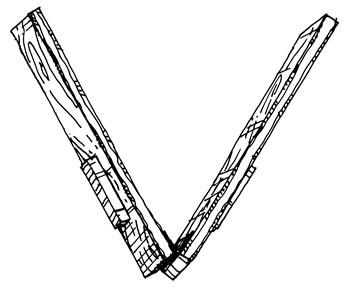
Install Scare Devices
A variety of devices can frighten a problematic owl. Increasing human activity in the area will keep most owls at a distance. Yelling and clapping hands, firing a gun loaded with blanks (it is illegal to shoot any owl), and banging cans together are all effective when an owl is seen nearby. A “clapper” can be constructed by putting a hinge on the ends of two, 24-inch 2 x 4s and smacking them together (Fig. 7). Any hesitation on the owl’s part will cut its odds of catching a targeted bird.
The “hawk globe” is basically a round mirror designed to scare an attacking hawk, or owl. If it is placed in the flight path the owl uses, an attacking bird will see its reflection and retreat, giving domestic birds a second chance. Because owls hunt on their own, they may avoid returning to a place where they perceive competition from another owl.
Scare devices reduce losses rather than eliminate them. Those who use these devices must be willing to tolerate occasional losses. If predatory birds are hungry, they quickly get used to, and ignore, frightening devices.
Dive-bombing Owls
Territorial owl behavior is not uncommon in Washington and across North America, especially in the spring and fall. Often the owl in question is a barred owl, but it could also be a great horned owl.
Owls may act territorial in response to perceived disturbances near their nesting sites and within their territories. The change in the photoperiod in the fall (the days getting shorter) and owl mating and nesting in the spring can both lead to more of this behavior than during other times of the year.
Owl encounters are most likely at night or during the early morning and late evening hours.
Owl attacks are generally rare, and the birds may hoot repeatedly before an attack to warn a person away from their territory or nesting area. If runners, hikers or others hear hooting, they should be aware, cover their head, and try to move along quickly.
If an owl does swoop towards or attack a human, wave your arms to deter the bird, and protect your head and face as much as possible. Leave the area as soon as possible and report the incident to WDFW and/or local land managers.
If you encounter repeated encounters with aggressive owls, you can call 877-933-9847, or submit an online report: wdfw.wa.gov/about/enforcement/report. Our biologists, other staff, and local partners will try to follow-up regarding repeat encounters, and we may place signs in the area to warn visitors about territorial owls.
Caring for An Injured Owl
Under federal and state law it is illegal for anyone to injure, harass, kill, or possess a bird of prey. Licensed rehabilitators are the only people legally permitted to transport and keep wildlife, including owls.
If you find an injured owl, contact a wildlife rehabilitation facility immediately. Your local wildlife office keeps a list of rehabilitators and can tell you which ones serve your area, or you can look under “Animals” or “Wildlife” in your phone directory.
If a rehabilitator isn’t available, follow the menu options over the phone or on their Web site for information on what to do. (For more information, see Wildlife Rehabilitators and Wildlife Rehabilitation.
Public Health Concerns
Owls are not a significant source of any infectious disease that can be transmitted to humans or domestic animals. A few human Salmonella infections have resulted from handling owl pellets in school settings. Wash your hands after handling owl pellets.
Legal Status
Owls are federally protected under the Migratory Bird Treaty Act. Any permit to lethally control these species would need to be issued from the U.S. Fish and Wildlife Service, and would only be issued in very extreme cases.
Additional information
Books
Ehrlich, Paul R., et al. The Birder’s Handbook: A Field Guide to the Natural History of North American Birds. New York: Simon & Schuster, 1988.
Nehls, Harry B. Familiar Birds of the Northwest: Covering Birds Commonly found in Oregon, Washington, Idaho, Northern California, and Western Canada. Portland, OR: Audubon Society of Portland, 1989.
Morse, Robert W., et al. Birds of the Puget Sound Region. R.W. Morse Company, 2003.
Peterson, Roger Tory. A Field Guide to Western Birds. Boston: Houghton Mifflin, 2001.
Internet Resources
Owl Pages (more owl calls)
Prevention and Control of Wildlife Damage